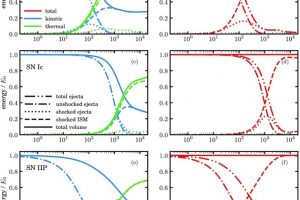The role of the magnetic field during the evolution of supernova remnants i. The study: “Magneto-hydrodynamic simulations of young supernova remnants and their energy-conversion phase” of O. Petruk (IAPMM NASU) recently appeared on MNRAS

Supernova explosions are sorted into two categories: The thermonuclear explosions triggered by white dwarfs in close binary systems (type Ia) and those triggered by the gravitational collapse of the core of massive stars (type Ib/c and II). Because of the paucity of known supernova remnants younger than 1000 years, astronomers developed several models describing the evolution of supernova remnants to study the connection between the properties of the remnants, the processes involved during the explosions, and their progenitor stars. Despite it has been shown that the magnetic field can play an important role during the evolution of the remnants, only a few models properly account for the presence of a local magnetic field, e.g. adopting a magnetohydrodynamic approach.
Following the studies of the astrophysics L. Woltjer during the ’70s, the evolution of supernova remnants has three main phases. At the beginning, the ejecta (which are the fragments of the progenitor star launched during the explosion with velocities of several thousands km/s) expand freely. This phase is followed by an adiabatic expansion of the remnant during which the radiative loss of energy are negligible (Sedov phase). During the last phase, the remnant form a thin and dense shell, which rapidly cools down because of the radiative energy loss (radiative phase).
The team of researchers led by the astrophysics O. Petruk (Institute for Applied Problems in Mechanics and Mathematics, Lviv, Ukraine) developed magnetohydrodynamic models describing the evolution of three different type of supernova remnants, including the effects due to the local magnetic field. The first model describes a type Ia supernova, with a white dwarf of 1.4 solar masses as a progenitor, releasing a total of energy of 1051 ergs. In this model, the blast wave expands in a inter- and circum-stellar medium with an uniform magnetic field. The other two models describe a core-collapse supernovae with the progenitor being a red supergiant star with a mass between 8 and 20 solar masses (type IIp) or a Wolf-Rayet star with a mass larger than 35 solar masses (type Ic). In all these cases, the evolution of the supernova remnant generally follows the Woltjer scheme. It is shown however that that this classic scheme should be supplemented with two intermediate stages: the energy-conversion and post-adiabatic regimes, because they have their own distinctive properties. The first one being actual since the young remnant start to feel resistance of the ambient medium and restructurizes from the freely expanding gas to the Sedov-like object. When the conditions of adiabaticity characterizing the Sedov phase are not satisfied anymore, the radiative energy losses becomes more important and the remnants is in a “post-adiabatic” phase. The authors also demonstrated how the magnetic field evolves during the lifetime of a supernova remnant. According to these simulations, the magnetic field is not important in setting the dynamics of the remnants until the end of the Sedov phase, while it starts playing an important role from the “post-adiabatic” phase. The study is described in the paper: “Magneto-hydrodynamic simulations of young supernova remnants and their energy-conversion phase“, recently appeared on the journal Monthly Notices of the Royal Astronomical Society. Among the coauthors, also the astrophysics S. Orlando of INAF – Astronomical Observatory of Palermo.
The figure (click here to visualize the entire image) shows the evolution of the energy components in the three different type of remnant described in this work: Ia (top panels), Ic (middle panels), and IIP (bottom panels). The green dashed line on the plot (e) almost co-insides with the green solid line and the green dotted line is almost zero there. Plots on the left display the kinetic (blue lines) and thermal (green lines) energy. Plots on the right show the total energy (kinetic plus thermal). Solid lines correspond to the whole SNR volume, dashed lines correspond to energies in the shocked interstellar medium only, dotted lines to the shocked ejecta, the dash–dotted lines to the unshocked ejecta and dash–dot–dot lines to the total energy in the ejecta.
Mario Giuseppe Guarcello ( follow mguarce) ( youtube)
Subscribe the Youtube of the Astronomical Observatory of Palermo
